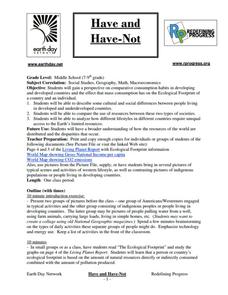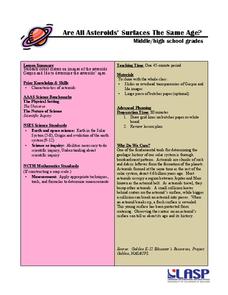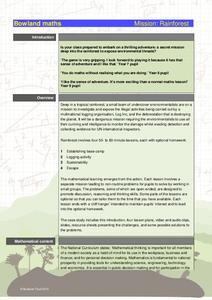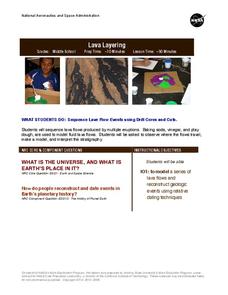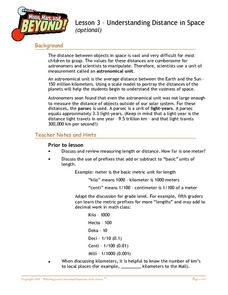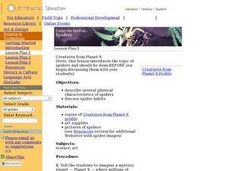Curated OER
Metric Conversion
Seventh graders convert within the metric system of measurement. In this seventh grade math/science instructional activity, 7th graders view a PowerPoint presentation that introduces metric conversion. Students use the...
Curated OER
Planet Earth in Cross Section
Students will examine the layers of the Earth. In this geology lesson, students create a scale model of the Earth's interior using cash register tape. They will determine the percentage of error in the scale compared to the actual size...
Curated OER
Fitting Periodic Functions-Distant Planets
In this periodic functions instructional activity, students use given data of the speed of a star and find the best fit periodic function that follows the trend in data. They determine the amplitude, offset phase and the formula for the...
Redefining Progress
Have and Have-Not
Is there a correlation between a country's wealth and the extent of its ecological footprint? What exactly constitutes an ecological footprint, and how does one country stack up against the rest? This is a unique instructional activity...
NASA
Solar System Scale & Size
Use a variety of whole fruits to represent the different planets in the solar system to introduce scale sizes to your math or space science class. They follow suit by creating a non-scaled model of the solar system using specific-colored...
Curated OER
Lotto or Life: What Are the Chances?
Though the website does not seem to have the mentioned video, a reding and lottery style games simulate the chances of finding intelligent life somewhere other than Earth. Without the video, this lesson is short, but it can be a useful...
Curated OER
Climate change in Canada
Students investigate the impact of human activity on the environment. In this secondary math/science lesson, students analyze and interpret information from data and graphs as they investigate trends in climate change and the...
Space Awareness
History of the Universe
Your pupils may believe that you and their parents are the oldest things in the universe, but surprise! There are elements of the universe that are even older. Elementary scientists create a class timeline to demonstrate the...
San Francisco Public Utilities Commission
Water from the Well
How much water does it take to brush your teeth? How about to wash your clothes? Perform an experiment that measures water usage in everyday tasks and compares them to the days before indoor plumbing, specifically the California...
University of Colorado
Are All Asteroids' Surfaces the Same Age?
Did you know scientists can tell the age of an asteroid by looking closely at its craters? This final lesson of a six-part series focuses on two asteroids, Gaspra and Ida, in order to demonstrate the concept of dating asteroids. Scholars...
Bowland
Mission: Rainforest
Young environmentally conscious mathematicians solve a variety of problems related to the central theme of uncovering illegal logging activities. They determine a base camp based on given constraints, investigate logging activities and...
Space Awareness
Making A Sundial
Can people really measure time just by using the sun? Scholars venture outside on a nice, sunny day to build sundials and learn how people measured time 600 years ago. The class builds two different sundials while gaining practice with...
NASA
Lava Layering
Take the old baking soda and vinegar volcano to the next level by using it to study repeated lava flows over time, examine geologic features on Earth and Mars, and speculate about some of the formations on Mars.
Curated OER
TE Activity: Space Shelter
Students simulate that they need to develop a new home on a different planet. They design a shelter that will ensure their survival after researching the characteristics of the other planet. They write an essay about their home design.
Alabama Learning Exchange
Properties of Minerals
High schoolers explore the basic building blocks of our planet. In this minerals lesson high schoolers begin the process of forensics on the basis of investigation and drawing conclusions from observations.
Curated OER
Understanding Distance in Space
Students discover the vocabulary used for distances in space and review measurement units and instruments before creating a scale model of the planets. They determine how to calculate the relative distances between the planets using a...
Curated OER
Gravity: It's GREEEAAATTT!
Students calculate effects of gravitational force on planets, discuss the effects of weightlessness on the human body and describe and demonstrate how objects in a state of free fall are accelerated by gravity at an equal rate.
Curated OER
Creatures from Planet X: Spiders
Students are given a description of some fascinating animals from "Planet X". They follow the descriptions given to illustrate one of these animals paying careful attention to introduced vocabulary such as 'appendages', 'receptors', and...
Curated OER
Children's Literature Across the Curriculum Ideas-Challenger: America's Space Tragedy
Young scholars read Challenger: America's Space Tragedy by MichaelD. Cole. They complete a variety of cross-curricular activities surrounding the study of the Challenger space shuttle tragedy. Included are reading, art, math, science,...
Curated OER
Exploring Jupiter: Galileo Curriculum Module Issue One
In this exploring Jupiter: Galileo Curriculum Module issue one activity, students complete a crossword puzzle that tests their knowledge of Jupiter; their are 11 links to other worksheets to explore the planet.
Curated OER
Fractions in Space
In this fractions in space worksheet, students solve 4 problems where they find ratios of orbit periods of satellites, they find the ratio of Neptune's and Pluto's periods, they determine the location of the planets after 5 opposition...
Curated OER
The North (Wall) Star
Students engage in a instructional activity which shows them that celestial navigation is the art and science of finding one's geographic position by means of astronomical observations, particularly by measuring altitudes of celestial...
Curated OER
Rover Races
Students identify the challenges encountered by astronauts in operating a planetary rover. In this space science instructional activity, students create a rover using their team members. They follow a command sequence from the driver and...
Curated OER
Groups, Clusters and Individuals
In this galaxies, clusters and planets worksheet, students solve 5 problems including determining sunspot groups on the sun in a particular day, finding the number of individual galaxies present, determining the number of stars in...



